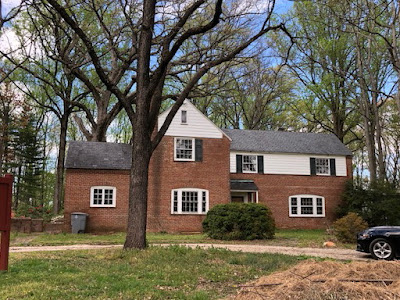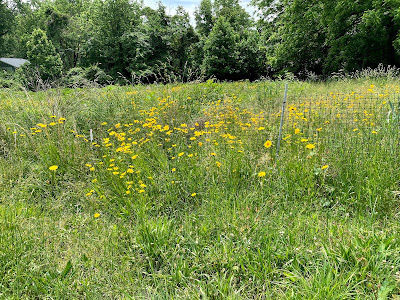Margaret White wouldn’t have wanted a ‘resident curator’ for the park that bears her name, her son says
 |
| The flowering plants at the White Gardens are being overtaken by invasives. |
The Fairfax County Park Authority is seeking a “resident curator” to live in and restore the house at the Margaret White Gardens, but that’s not what Margaret would have wanted, says her son Doug White.
“She didn’t care whether the house was torn down,” Doug says. “She was attached to the property, not the house.” Her idea was to have the landscaping preserved and an educational center in the park focusing on the ornamental plantings – mostly rhododendrons and azaleas – and the way they were displayed.
 |
| The house where Doug White grew up is not architecturally or historically significant. |
The Resident Curator Program, however, calls for someone to rehabilitate the house while living there rent free.
The 13-acre property, now known as the Margaret White Gardens, is at 6711 Princess Lane in the Falls Church area of Mason District. The public is invited to an open house on Saturday, Aug. 7, 10 a.m.-2 p.m.
John C. and Margaret White built the house in 1939 and raised five children there. John, known as JC, died in 1979, but Margaret continued to live there until 2010 when she died at age 103.
Related story: Park Authority seeks ‘resident curator’ to restore the house at the Margaret White Gardens
In the late 1990s, Doug says, Margaret asked her children whether they wanted to live in the house, but everyone was settled in their own place. In 1999, she deeded the property to the Park Authority to prevent it from being turned into a housing development. The agreement allowed her to continue to live in the house for the rest of her life.
 |
| The meadow |
John White had been a lawyer in Texas, and when the firm made him a partner based in Washington, D.C., he and Margaret wanted to live in the country so they bought an old pig farm.
When Doug was little, they had chickens and two pigs, Sarah and Gwendolyn, who used to jump the fence and run toward a neighboring farm. They had a garden where they grew corn, okra, and tomatoes, and Margaret would do a lot of canning. They also had an orchard with peach, apple, and sour cherry trees, and she would make pies and preserves.
“Farming was my father’s hobby,” Doug says. Later on, his parents began to focus on ornamental plants.
That started when John bought Margaret azaleas for Valentine’s Day and started planting them near the house. They expanded to rhododendrons and camellias, but most of the camellias got wiped out during a really cold winter in the 1980s.
 |
| The Park Authority plans to seek a separate resident curator for the barn at the Margaret White Gardens. |
Doug and all but one of his siblings went to Sidwell Friends School in D.C. “After school, we’d come home to his lovely place. It was a great place to grow up.”
The Whites hired a local farmer, Mr. Kerns, who had a big dairy farm on Kerns Road, to hay the field, Doug says. It was full of wildflowers in the spring, and the kids used to sled there in the winter.
They used to roller skate and have dances in the old barn. One summer, when the kids were away at camp, their parents dug a pond for a swimming hole. But it was “real oozy on the bottom and no one wanted to go in there,” Doug recalls.
Related story: The John & Margaret White Horticultural Gardens – What happened to the bond money?
https://annandaletoday.com/2020/11/the-john-margaret-white-horticultural.html
“After the Korean War, things really started to get developed,” he says. A housing development was built on the Kerns farm, and in time, the entire White property was surrounded by homes.
By the time Margaret grew old, the house had deteriorated. The wallpaper was peeling, and it needed major repairs. “She thought it was a waste of money to fix up the house,” Doug says.
When the Park Authority took possession of the house, they removed the greenhouse and the copper gutters. Doug estimates it would take at least $500,000 to bring it up to code. “It’s beyond me what the county is thinking” in contracting with a resident curator, Doug says. “Who would spend thousands of dollars and not own it? It makes no sense at all.”
Meanwhile, he says, the Park Authority spent thousands of dollars on the park – including $150,000 to pave the driveway – but didn’t provide promised improvements, such as a shelter, pathways, and signage.
 |
| The pond is a haven for frogs. |
“They let the field grow wild for eight years or so, then spent $80,000 to restore it as a meadow,” he says. “I don’t think anyone is accountable.”
“What the Park Authority should have done first,” he says, “is get rid of the invasive plants. Instead, they expect volunteers to come and do the weeding.”
If his mother knew how the Park Authority mismanaged the property, Doug says, she might have given it to the Nature Conservancy instead.


A very enlightening article. I've watched this park go to weeds over the past decade – quite a shame.
Lesson learned: Don't leave your land to a government entity. Whether the federal, state or local level, they just never seem to get it right.
This part of the article is intriguing. "Meanwhile, he says, the Park Authority spent thousands of dollars on the park – including $150,000 to pave the driveway – but didn’t provide promised improvements, such as a shelter, pathways, and signage. "
Simply – Why not? Where did the money go?
what a waste of Fairfax county funds. We should just let these properties go back to woods.
Thank you, Mr. White, for sharing your story.
I am beyond dismayed at the plan for this resident curatorship.
With no plan for the park, placing a resident in the house will re-privatize the property, discourage public visits even more than they are discouraged today.
It will be a nice setting for someone in the house, that’s all. There will be the occasional person who lives next to it walking the dog. As you point, Mr. White, there are no trails, no shelters, no signs.
There is not even so much is one bench to make a member of the public feel welcome, like this is their place. Oh, but you will be invited to come to pull vines.
And this will not have been cheap for the taxpayer. Hundreds of thousands of bond money dollars have been spent on reports: master plan, cultural landscape report, historic structures report, archaeological study, plant study, with none of these reports even available to the public save the master plan which is being ignored. Then there is the cost of administering the program itself.
As far as pure preservation, it would be much better to have a program to encourage private homeowners to put a conservation easement on their property and sell it.
That way it gets preserved from development, and the county still gets some property tax revenue.
And if the county can go to all the trouble to develop a resident curatorship partnership instrument for houses why not for a park itself? Why don’t we have a program where whereby we encourage one or more groups to come into the garden who have some educational mission, some mission compatible with the park? Let them make a home there, ask for a percentage of any fundraising they do to go towards the park upkeep, so that the park itself can incrementally grow.
I am truly sorry, Mrs. White. As you said long ago it was your children who agreed to give up substantial inheritance so that this could be a place for people to enjoy nature and horticulture.
The White Gardens is not the only park suffering this neglect. Lahey Lost Valley in Vienna, a few miles from the successful Meadowlark Gardens (Northern Virginia Regional Park Authority) , and Wolf Trap (National Park Service / Wolf Trap Foundation for the Arts) was deeded to the Park Authority in 1999 by Carlotta Lahey. She was an artist and widow of Richard Lahey (Ashcan school of artists, former principal of the Corcoran School of Art), to have an arts focus. It has a house, and a separate one-room studio building. Mrs. Lahey donated her art collection to the Park Authority as part of the gift. Is it that hard to incrementally start something? Artists have traditionally not been wealthy.
It is a beautiful 22+ acre park and shares the same emptiness as the white gardens. I had trouble finding an entrance when I visited.
What we need is a trust or other non-governmental entity that could make these treasure sites bloom so to speak, make them a place of renewal and inspiration for all of us: fulfill the promise that was made when they were acquired.
The resident curatorship is a good program for the right setting and park plan. It should serve to enhance the park experience.
White Gardens is not that place. Fairfax County, if the house cannot serve the public, demolish it and get to work on what you told the public you would do when you spent all that money and effort on your master plan. And work with the public to preserve that beautiful barn, with public access as the ruling principle.
White Gardens should be wonderful, not forgotten. And we need to have higher expectations for the care with which our precious tax dollars that pay for bond principal and interest, are spent.
The resident curator thing is strange. Why can't the park authority make these properties proper parks? It seems like they are banking on selling the land at a later date down the road if they don't make it a fully available park.
But, any property that is saved from development for the time being is a win. I am always dismayed when I see houses dotting once green, treed, or open spaces. I'm sure that's what his mother wanted, and the county is upholding that end of the bargain.
The Nature Conservancy doesn't want to preserve your property. From their website: The Conservancy will sell the property and use the proceeds to support vital programs. In very limited cases we may use the property for our own purposes.